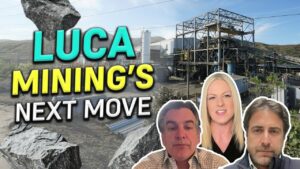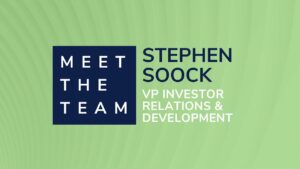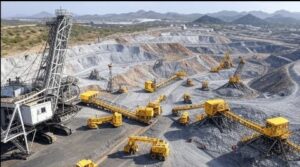Executives
Devin Sullivan – Senior Vice President
Rene J. Robichaud – Chief Executive Officer, President and Director
James R. Easter – Chief Financial Officer
Jerry W. Fanska – Former Principal Financial Officer, Principal Accounting Officer, Senior Vice President of Finance and Treasurer
Analysts
Cory Mitchell – D.A. Davidson & Co., Research Division
Gerard J. Sweeney – Boenning and Scattergood, Inc., Research Division
William Richard Nasgovitz – Heartland Advisors, Inc.
Layne Christensen (LAYN) Q1 2014 Earnings Call June 5, 2013 11:00 AM ET
Operator
Good day, ladies and gentlemen, and welcome to the Layne Christensen Company Reports Fiscal Year 2014 First Quarter Financial Results. [Operator Instructions] As a reminder, this conference may be recorded. I would now like to introduce our host for today, Mr. Devin Sullivan from The Equity Group. Sir, please go ahead.
Devin Sullivan – Senior Vice PresidentThank you, Karen. Good morning, everyone, and thank you for joining us today for Layne Christensen’s Fiscal 2014 First Quarter Conference Call. Our speakers for today will be Rene Robichaud, President and Chief Executive Officer of Layne Christensen; and Jim Easter, Chief Financial Officer. Also participating on the call is Jerry Fanska, Layne’s Senior Vice President of Finance.
Before we get started, I’d like to remind everyone that statements made during today’s call may contain forward-looking statements within the meaning of Section 27A of the Securities Act of 1933 and Section 21E of the Exchange Act of 1934. Such statements may include, but are not limited to, statements of plans and objectives, statements of future economic performance and statements of assumptions underlying such statements and statements of management’s intentions, hopes, beliefs, expectations or predictions of the future.
Forward-looking statements can often be identified by the use of forward-looking terminology such as should, intended, continue, believe, may, hope, anticipate, goal, forecast, plan, estimate and similar words or phrases. Such statements are based on current expectations and are subject to certain risks, uncertainties and assumptions, including, but not limited to, the outcome of the ongoing internal investigation into, among other things, the legality under the FCPA; and local laws of certain payments to agents and other third parties interacting with government officials in certain countries in Africa relating to the payment of taxes and the importing of equipment, including any government enforcement action, which could arise out of the matters under review or that the matters under review may have resulted in a higher dollar amount of payments or may have a greater financial or business impact than management currently anticipates; prevailing prices for various commodities; unanticipated slowdowns in the company’s major markets; the availability of credit; the risks and uncertainties normally incident to the construction industry; the impact of competition; the effectiveness of operational changes expected to increase efficiency and productivity; worldwide economic and political conditions and foreign currency fluctuations that may affect the worldwide results of operations. Should one or more of these risks or uncertainties materialize or should underlying assumptions prove incorrect, actual results may vary materially and adversely from those anticipated, estimated or projected. These forward-looking statements are made as of the date of this filing, and the company assumes no obligation to update such forward-looking statements or to update the reasons why actual results could differ materially from those anticipated in such forward-looking statements.
With that said, I’d now like to turn to go over to Rene Robichaud. Rene, please go ahead.
Rene J. Robichaud – Chief Executive Officer, President and DirectorThank you, Devin, and good morning, everyone. Thank you, all, for joining us today. I’d like to begin by welcoming Jim Easter as Layne’s new Chief Financial Officer. We announced Jim’s appointment in early May and are very excited that he has joined our company. Jim has had a varied and successful career in finance, mergers and acquisitions, and energy services, as well as managing global companies throughout distinct life cycles. We expect Jim’s experience, vision and counsel will be vital components of our continuing evolution. I would also like to share with you that, myself, Jim and several other of Layne’s senior executives and other personnel, have relocated to temporary space in The Woodlands, Texas. We expect the rest of our team to move into our new headquarters, in stages, by October of this year.
Our results for Q1 were disappointing and reflected many of the same challenges that we encountered in the fourth quarter of fiscal 2013. As we discussed last quarter, our overall profitability in Q1 was, in fact, impacted by temporary weakness at Geoconstruction; corporate overhead costs, primarily costs associated with the consolidation of our headquarters in the Houston area; and unfavorable comparisons at Mineral Exploration.
To add some perspective of the $24.2 million pretax loss in Q1, approximately $5.4 million was attributable to Geoconstruction, as that division struggled through low utilization caused by project cancellations and delays in the United States related to economic uncertainty, as well as temporary work stoppages in Brazil, which have since been resolved. Also, $3.7 million of the pretax loss was associated with the move to The Woodlands. $1.7 million was associated with overhead expenses at Diberil, which was not consolidated in last year’s first quarter. And another $1 million was associated with higher legal and other fees related to FCPA. Some of these challenges persist and could linger through fiscal year 2014, impacting our overall results for the year. We expect to record an additional $9 million in costs associated with our headquarter consolidation in the Houston area during the remainder of fiscal year 2014. And results at Geoconstruction will likely remain soft for at least another quarter until more of our book business starts up.
We’ll also continue to invest in our new and growing Energy Services Division. Our overall theme of diversifying our business away from the hard bid municipal market and toward higher margin, reduced competition and negotiated project work continues at our Heavy Civil and our Water Resources divisions. I will discuss this in a few minutes.
We’ve worked through a number of other challenges as Q1 progressed. While we understand that most investors review and digest our results on a comparative quarterly basis, our division profit performance on a consecutive quarterly basis, that is comparing Q1 to Q4, bears noting.
At Water Resources, we went from a loss before taxes of $4.6 million, which included a $4.4 million impairment charge, to essentially breaking even in Q1. Inliner’s profitability rose by 16% from the immediately preceding fourth quarter and we expect continuing good performance at this segment for the balance of the year. Heavy Civil, by far the most challenging of our businesses this past year, demonstrated the most dramatic turnaround over the quarterly 3-month period, improving from a loss of over $10 million to a loss of just under $1.5 million.
Mineral exploration improved its pretax profitability by $2 million from a loss of nearly $900,000 in the fourth quarter to income of $1.1 million in the first quarter. Unfortunately, Geoconstruction bucked this positive division profitability trend, widening its loss from $4.1 million in Q4 to $5.4 million in Q1.
Our newest reporting segment is Energy Services. We launched this division’s Water Transfer business in May in the Permian Basin. We expect the mobile water treatment business will commence this summer. We continue to target a $20 million annual revenue run rate for this division by the end of this fiscal year. The client feedback we received on our first commercial water transfer job was very encouraging. Our client, a large independent E&P company, said that we were “the most professional team that they had ever seen in water transfer.” Ironically, we know we can do better than what they saw. Our water transfer system is designed to be safe, fast and sustainable, meaning, leakproof.
Our One Layne driven opportunities are developing nicely. As a result of adopting our One Layne business development plan last year, we’re currently working on over $100 million of projects that involve 2 or more Layne divisions, and we’re pursuing over $1.1 billion of potential projects that leverage and combine the new unique skill sets of our various division professionals.
By way of example, our Energy Services team is leading our Heavy Civil and our Water Resources divisions on a potential plus-$200 million water supply project in South Texas intended for both the hydraulic frac-ing market and the local municipalities. This is an exciting opportunity for Layne to demonstrate its considerable water management skills for both the energy market and the municipal market. Also, our Mineral Exploration team is introducing our Geoconstruction team to our mining clients as a function of the horrible mine wall collapses, which have put large copper mines out of business for considerable period of time. This morning’s press release touches on some of the drivers in each of our division this past quarter. I’ll now provide you with an update at these segments.
In Water Resources, we believe the slowdown in injection well drilling in Florida is temporary as we have one work there, which will start in the third quarter, and we are quoting several other projects now. As previously discussed, during fiscal year 2013, approximately $78 million of Water Resources revenues came from domestic industrial clients, not municipal clients, far surpassing our goal of $50 million. Most of this work was generated by our specialty drilling group, which has since been transferred to our Mineral Exploration or international team.
Our industrial work, or nondrinking water work, amounted to $13.3 million in the first quarter and we expect the same level of activity this quarter. Our repair and installation work, or R&I work, is great repeat business from municipalities and amounted to $21.6 million in revenues in the first quarter, up 9% over last year. Water Resources is on track to meet its R&I revenue goal of $85 million this year. Water Resources is leading the pursuit of an attractive $30 million One Layne opportunity involving Heavy Civil for the development of water sourcing and treatment and transfer from a brackish-water source in California to be used by local municipalities and the agricultural industry there. The outlook for Water Resources we expect to be profitable in the second quarter with much improved financial performance in the second half of the year.
For Inliner, higher profits were related due to true-ups at the end of certain projects and higher sales of our liners to third parties. With respect to our new work, Inliner is very busy in the Washington D.C. area. Third-party sales of lining products was up $1.6 million in the first quarter to $3.1 million and we expect this level of sales to continue growing. We are also on track to complete our new fiberglass wet-out facility in Southern Indiana this summer. This is a proven technology widely used in Europe, which we feel will help us grow Inliner nicely. The outlook for Inliner, we believe that Inliner can generate record profits in the fiscal year 2014. This would be the eighth consecutive year of record profits for the Inliner division.
At Geoconstruction, well, this business has always been lumpy. We had 4 years of record profits leading up until we ran into the fourth quarter last year. Although we expected better performance from Geoconstruction in the first quarter, I’m happy to say that the bidding environment has improved considerably. We’re starting to win important new work in areas including Brazil, Canada and the United States. Yesterday, Tutor Perini was awarded the $840 million San Francisco Central Subway station construction project. Layne’s Geoconstruction division has been named a subcontractor for over $50 million of this work. The impact of this award should become apparent in Q3 and in Q4 of this year. Although not included in our estimates, we are currently awaiting approval on change orders on a number of projects. These changes would favorably impact the quarter in which they are recognized. The outlook at Geoconstruction is that the second quarter will likely mirror the first quarter with a much stronger second half as the new projects come online.
For Heavy Civil, this is the most significant improvement we have at Layne given its project troubles during all of fiscal year 2013. Revenue in Heavy Civil increased compared to Q1 fiscal year 2013 and more significantly compared to Q4 fiscal year ’14, as a result of the inclusion of revenues from our previously announced Islamorada project in Florida. Our loss for the division also narrowed significantly due to the combination of higher margin new business, completion of lower margin legacy projects and gains on the sale of some surplus equipment. We do expect to see a lagged improvement in the demand for Heavy Civil services as the housing recovery continues. Over 40% of the work booked in the last year has been what we call alternative delivery or reduced competition work, which is better for us than the standard hard bid municipal work. Our key to success is continued discipline in our pricing, our project management and our cost controls. As for the outlook here, we’re on track to return to profitability in Heavy Civil by the middle of fiscal year 2014. Also, please note that Heavy Civil leaves more of our One Layne potential opportunities than any other division.
Regarding Mineral Exploration. Despite the global downturn in commodity prices, our MinEx division returned to profitability in Q1. We continued to be aggressive in aligning this division’s cost structure and will continue to take whatever steps are necessary to maintain profitability while the industry recovers. Africa and Australia remain slow. The coup in Mali, which caused us an estimated $3 million in profits last year, had stabilized. We envision increasing our work there following the wet period, which typically ends in October. Successful One Layne work has materialized with a mining client in Brazil, together with our Geoconstruction team, and water sourcing work with a mining client in Mexico. Several other One Layne opportunities are being led by the mining exploration team.
In Ethiopia, we’re doing great work here drilling for water wells. For many years, the Chinese and other drillers have worked here developing wells at about 300-meter depths, which took 6 to 8 months to complete, and produced roughly 300 gallons per minute. Layne is new to this scene but is now producing water wells in the very same fields in 1 month, that produced 3 to 5 times as much water. We’ve definitely gotten the attention of the Ethiopian authorities with this performance. Some feel that Ethiopia will need 50,000 water wells in the next 25 years. This is a big opportunity for us.
Regarding our Mineral Exploration outlook. We expect MinEx to be profitable, although, at a lower level than last year. Our rig utilization rate is 58%, up from the low of 48% during December and January. The global exploration outlook remains challenged and will likely remain so for all of fiscal year 2014. Lower exploration budgets are expected from the majors, while the junior mining company struggled in a persistently weak capital raising environment. We believe that exploration programs will continue but at a slower pace due to lower commodity prices and, in some cases, as mining companies work through the integration of large acquisitions.
With respect to all of Layne’s, we expect our performance in several divisions to improve this quarter. Furthermore, we expect performance at all of our divisions to significantly improve in the second half of this year.
A moment about our safety. Safety is one of Layne’s 4 core values. About 18 months ago, we embarked on an ambitious worldwide culture change, which included our attitudes about safety. Our results so far are outstanding. We’ve lowered our recordable incident rate by 33% and our long-term and days away rates by over 50%. Our people have responded to this program in a very positive way. They are simply fantastic professionals.
I’ll now turn the call over to Jim Easter, who will review our Q1 results. Jim?
James R. Easter – Chief Financial OfficerThanks, Rene, and thanks to each of you for participating in today’s call. We expect to file our Q with the SEC on Monday, June 10. Before I get into the financial section and since this is, after all, my first conference call since joining Layne, I want to say that despite the challenges we face currently in some of our markets, I’m very excited to be here and I’m looking forward to working with the Layne team and also getting to know many of the people who’ve taken time to dial into this call.
So moving on to the financials, our revenues declined 16.7% from $271.8 million in Q1 ’13 to $226.4 million in Q1 ’14 due to revenue declines in all segments, except for Heavy Civil and Energy Services. For the quarter, Heavy Civil revenues increased $73.8 million in Q1 ’14, but more significantly, it rose by $15.4 million from the immediately preceding fourth quarter of fiscal 2013. Cost of revenues for the current quarter were $189.6 million or 83.7% of revenues compared to $218.9 million or 80.5% of revenues for Q1 ’13, due primarily to the effect of late stage work at Geoconstruction, as well as project delays and cancellations within this division. Mineral Exploration was also responsible for some of the percentage increase and the speed of which we implemented our cost reductions did not keep pace with the decline in revenues in this business unit.
Our SG&A expenses increased 6.4% to $41.9 million from $39.4 million in Q1 ’13, primarily due to $3.7 million in expenses associated with the relocation of our headquarters to The Woodlands; $1.7 million in overhead expenses at Diberil, which we did not consolidate in Q1 ’13; and additional $1 million accrual associated with the FCPA investigation. These expenses were partly offset by $4.2 million reduction in comp expenses.
Depreciation, depletion and amortization increased 10.6% to $15.3 million for Q1 ’14 from $13.8 million for Q1 ’13, primarily the result of a $1.1 million expense associated with the Diberil acquisition.
We reported a loss in equity and earnings of affiliates of around $500,000 as compared to earnings of $7.8 million in last year’s quarter, primarily due to the global decline in MiNex.
We recorded $1.9 million of equity and earnings of affiliates in last year’s first quarter, which was attributable to our, then, partial entries in Diberil. Since we acquired the remaining equity interest, there are no longer any associated equity earnings.
Interest expense increased to $1.3 million for Q1 ’14 from $600,000 in Q1 ’13, reflecting increased borrowings on our revolving credit facility to fund capital expenditures and for working capital needs. We continue to expect debt levels to come down in the coming months as profits improve. We’re also selling surplus or underutilized equipment and we certainly continue to focus on working capital reductions. In that regard, we’re able to reduce long-term debt by about $10.7 million during the first quarter from the end of the fourth quarter fiscal ’13.
Finally, other income of $3.7 million consisted primarily of gains on the sales of surplus equipment. Our pretax loss for the quarter was $18.3 million compared to a pretax gain of about $8 million in last year’s first quarter. We’ve reported a net loss of $23.8 million or $1.22 per share compared to net income of $3.8 million or $0.19 per share in last year’s first quarter.
Several notable items made up the Q1 loss. Despite this loss, fiscal ’14’s first quarter, we recorded an income tax expense of $5.8 million compared to an income tax expense of $3.3 million in last year’s first quarter. This expense was a result of the discrete period noncash valuation allowance of $8 million against our foreign tax credits generated in prior years. Excluding the valuation allowance, the effective tax rate’s continuing operations for Q1 ’14 and Q1 ’13 would have been a benefit of 11.9% and an expense of 41.7%, respectively.
Our cash position at April 30, 2013, was $27.2 million. We had working capital of $108 million, long-term debt less current maturities is about $86 million, our shareholders equity was $390 million or $19.69 per share.
Before turning it back to Rene, I’ll just make a few comments on the balance of 2014. We will continue to focus on our liquidity by managing our operating expenses and reducing costs wherever possible. We continue to look for non- or underperforming assets on our balance sheet that can be converted to cash and we are aggressively managing our daily working capital.
Now on a more positive note, we are making progress on our move to Houston. We are very encouraged by the new people that we brought into the company, already, who will be joining us shortly. And we expect to be in our permanent location in mid-September and estimate roughly $9 million will be expensed toward the balance of this year in connection with our relocation.
I’ll now pass it back to Rene.
Rene J. Robichaud – Chief Executive Officer, President and DirectorThanks, Jim. Quarter-over-quarter, we’re seeing measurable and, we believe, sustainable progress along a number of fronts as we address the opportunities inherent in the dynamic end markets in water, mineral and energy resources. We believe that our results will continue to improve throughout fiscal year 2014 and we appreciate your continuing interest in Layne.
With that, I’ll turn the call over to the operator for questions.
Question-and-Answer Session
Operator
[Operator Instructions] Our first question comes from the line of Cory Mitchell from D.A. Davidson.
Cory Mitchell – D.A. Davidson & Co., Research DivisionJim, first, what was the current debt outstanding?
James R. Easter – Chief Financial OfficerThe current debt outstanding is…
Rene J. Robichaud – Chief Executive Officer, President and DirectorAs you mean short term and long term added up, that’s what we’re just checking…
James R. Easter – Chief Financial Officer$14.4 million. Sorry.
Cory Mitchell – D.A. Davidson & Co., Research DivisionAnd then also with regards to Water Resources, how temporary do you think the slowdown is in Florida? When do you think the pressure should abate there?
Rene J. Robichaud – Chief Executive Officer, President and DirectorDefinitely in the third quarter. I don’t think we’ll see it in this quarter. The biggest change in Water Resources had to do with our injection well projects slowing down for power utility companies. We’re seeing that come back. We’re booking the business now and it’s kind of revving up nicely, but it really won’t get going until the third quarter and then fully going in the fourth quarter.
Cory Mitchell – D.A. Davidson & Co., Research DivisionAnd then moving on the Heavy Civil, could you give me an indication of how much of the lower loss was caused by higher margin versus gains on sales of equipment?
Rene J. Robichaud – Chief Executive Officer, President and DirectorIt’s about $1 million.
James R. Easter – Chief Financial Officer[indiscernible] $1 million in asset sales in the quarter, so not a lot there.
Cory Mitchell – D.A. Davidson & Co., Research DivisionI didn’t get that. Will you repeat it, please?
Rene J. Robichaud – Chief Executive Officer, President and Director$1 million in gains, Cory.
Cory Mitchell – D.A. Davidson & Co., Research DivisionAnd then depreciation going forward, could we kind of expect this as the going forward run rate?
James R. Easter – Chief Financial OfficerYes. At this business level, I don’t think it’s going to change that much.
Operator
[Operator Instructions] We also have a question from the line of Gerard Sweeney from Boenning.
Gerard J. Sweeney – Boenning and Scattergood, Inc., Research DivisionI just want to thank Jerry Fanska, there. I know this is probably your last call, so thanks for all your help over the past couple of years.
Jerry W. Fanska – Former Principal Financial Officer, Principal Accounting Officer, Senior Vice President of Finance and TreasurerWelcome.
Gerard J. Sweeney – Boenning and Scattergood, Inc., Research DivisionSo I want to touch on Water Resources again. I know you did mention that, I think, the Florida business was the key focus or the key — one of the key areas that sort of slowed down. But you didn’t mention in the press release that you did see slowness across the country. Anything in particular? I mean, is this levered to sequestration at all? Is there — is that a function of anything in the Water Resources business?
Rene J. Robichaud – Chief Executive Officer, President and DirectorI’d love to be able to tag it that simply but I won’t, it’s not that. It’s more municipalities on the origination side, trying to tighten their belts in various parts. And so we have not seen a great deal of new development work throughout the country for sourcing and treating and transporting water in these communities. Now the enhancement in the new housing starts and the inventory of houses available for sale coming down so sharply, I mean, these are positive trends for us but I’m not expecting to hit us until next year, Gerry.
Gerard J. Sweeney – Boenning and Scattergood, Inc., Research DivisionOkay. Yes, I think of the housing fund. I mean, the way I always viewed it was, there was probably a build out of these developments and some of the infrastructure was in place so they had this vacant pad that still had some homes that needed to be built so that would be a lagging need — would be some infrastructure. Is that the same thought processes that you’re looking at?
Rene J. Robichaud – Chief Executive Officer, President and DirectorYes. That’s fair.
Gerard J. Sweeney – Boenning and Scattergood, Inc., Research DivisionOkay. And then Geoconstruction, that would have been the second half of sequestration. How much is Geoconstruction in the U.S. to work with the Army Corps of Engineers? I know they furloughed people in March and April. Any thoughts on that?
Rene J. Robichaud – Chief Executive Officer, President and DirectorWe do a lot of great work for the Army Corps of Engineers. We’ve been hired by them to fix some of the worst dams in the United States, the last project was Clearwater, Missouri. We’ve been hired by them after Katrina to stabilize the new levies being put in and around New Orleans. So the Army Corps is a great client of ours and we expect — and we’re bidding on more work that’s coming, there’s big dam projects that are coming, as well as other projects. So we’re not expecting those dam projects to hit us this year but that would be business for next year.
Gerard J. Sweeney – Boenning and Scattergood, Inc., Research DivisionOkay. I mean, would you characterize it as — I mean, there are — that work has to be done, I imagine at some point but, I mean, there’s probably some new answers on what goes on with sequestration, whether it be some outright cancellation of projects all the way shifting towards maybe less pushback work because there’s not enough manpower. I mean, are you seeing — can you give us new ones on what’s going on there on that front and how it affects the Geoconstruction?
Rene J. Robichaud – Chief Executive Officer, President and DirectorYes. Well, the worst thing that affects the Geoconstruction is the San Francisco Central station job that we had won that we were starting to work on — we’re prepared to start to work in the fourth quarter. It was a $28 million job and it was canceled on us. And so we’d set ourselves up for that work, which would have eliminated the losses in the first quarter. So when that job was lost, replacing it in the short term was very hard. Now how are you going to attribute why the project was canceled in the fourth quarter and why it’s just being rebid as of yesterday? I’m not going to tell you why that was done but we’re delighted that it’s back, we’re delighted that we’ve been picked again, we’re delighted that the $28 million job that got canceled in the fourth quarter is turning in to a over $50 million job for us with the potential to go higher on this important San Francisco Central station project.
Gerard J. Sweeney – Boenning and Scattergood, Inc., Research DivisionAnd that, that, too, to prevent that $50 million I mentioned Tutor Perini?
Rene J. Robichaud – Chief Executive Officer, President and DirectorTutor Perini will be the general contractor on this.
Gerard J. Sweeney – Boenning and Scattergood, Inc., Research DivisionOkay. And is that in the backlog for Geoconstruction?
Rene J. Robichaud – Chief Executive Officer, President and DirectorNo. We’ve been named as the subcontractor but until we formally sign it now, which again it was only issued yesterday to Tutor Perini, until we formally sign it, we will not put it in the backlog.
Gerard J. Sweeney – Boenning and Scattergood, Inc., Research DivisionOkay. Got it. Understood. Finally, MinEx, obviously, there’s headwinds maybe a global — the super-cycle slowing down, barge acquisitions being digested. But one of my thought processes was China saw — there’s been — their method of handling the post-great recession or handling the recession was still a lot of money of stimulus infrastructure. And maybe that drove up some of the demand for ore — iron ore, whatever have you, and drove up overall demand. With that coming out of the market, I mean, my sense is, there’s going to be a resetting of, I guess, total demand across the market for Mineral Exploration services. I want to see what your thoughts are and how that’s developing or if you’re going to agree with that assessment and what timeframe it will take to figure this all out?
Rene J. Robichaud – Chief Executive Officer, President and DirectorIn my mind, a lot of the China slowing of growth has already been absorbed into the marketplace. And the law of large numbers has an important impact here because China is already a large economy, the second largest in the world and it’s still growing at a very sharp cliff. So that’s not going to stop for another generation. We still have hundreds of millions of people who are virtually dirt poor. India has at least the same problem, Indonesia as well. Africa, all over the continent. Industrializing the world’s poor people is a phenomenon that will not stop and that’s going to require a great deal of construction and a great deal of natural resources to make happen. So people say the end of the super-cycle is this. It’s the last super-cycle that will ever happen. That’s probably highly unlikely. Now this one has definitely cooled down and it kind of surprises me because the cool down that we saw in January of 2009 was very understandable. All the commodity prices collapsed in January 2009. Today, the price of copper is still at a very healthy $3.30 a pound plus some. And the price of iron ore has come up in the last 6 months from a desperately low price below $100 to, depends on what price you’re looking at, but a decent long-term outlook for iron ore as well. So my view is the major mining companies are sending an important message to the world’s governments, to the world’s labor unions and to us, their suppliers, that the price increases that we had, the labor actions that we’ve seen, that the higher taxes from governments, higher rents, higher royalties, windfall profit taxes, all that stuff materially affects capital expenditures. And so we are all on notice to reset our expectations there.
Operator
And our next question comes from the line of Will Nasgovitz from Heartland Advisors.
William Richard Nasgovitz – Heartland Advisors, Inc.Congratulations on the sequential uptick in the Heavy Civil. It’s great to see. I believe you touched on this in the last quarter. Can you just remind me the goals you have for that segment? Can we get back to the historical levels of profitability there?
Rene J. Robichaud – Chief Executive Officer, President and DirectorThe peak earnings for Heavy Civil was $14 million of operating income. I’m going to say in ’08, ’09, something like that and that’s the goal. It’s going to get back to that last target. This year, our target is breakeven operating income from the horrible performance last year, which was a direct result of bad decisions made in 2010 and 2011 where they chased riskier projects with lower margins and very low contingencies. That model doesn’t work and will never happen again.
William Richard Nasgovitz – Heartland Advisors, Inc.Switching gears to Energy. You mentioned you have a new, I guess, a mobility business starting this month. When this treatment start or has it already started?
Rene J. Robichaud – Chief Executive Officer, President and DirectorNo. Our first mobile treatment unit is rolling off this month and we expect to have it in commercial operation in the — if not this month, next month. People are pretty excited about this. I don’t want to talk about it until we see it run. I’d like to tell you how really pleased I was, personally, at how our client reacted to our first water transfer job. That is exactly the standard that Layne wants to bring in terms of water management to the hydraulic frac-ing markets throughout the United States.
William Richard Nasgovitz – Heartland Advisors, Inc.The distortions began, the transfers began, and now the treatment is starting, is that — I’m thinking about the pre-leg [indiscernible] that you talked about?
Rene J. Robichaud – Chief Executive Officer, President and DirectorPrecisely.
William Richard Nasgovitz – Heartland Advisors, Inc.Is there a uniqueness to the treatment side that you’re doing versus what’s out there today? Or can you just leverage a little bit on it?
Rene J. Robichaud – Chief Executive Officer, President and DirectorYes. I’d like to say nobody else can possibly do [indiscernible] but I think that’s a little strong. And I know part — parts of what we are putting in are different from what other people are doing. In the worst, nastiest produced water and flowback, our system is expected to be world-class. And that’s really our standard because we’re the water management people for municipalities. This is our core business. We will not go in there with any standard that’s below that. So some people may come in with lower standards, see what they can get away with in certain markets, that will not be how Layne operates.
William Richard Nasgovitz – Heartland Advisors, Inc.Last, just going back to Mineral, congrats on the profitability there. I apologize if you touched on this, have you seen an ounces of precious metals lying closer, whether it’s gold or silver, what have you seen out there?
Rene J. Robichaud – Chief Executive Officer, President and DirectorWell, the mine closures that we’ve seen are Gresford mine, which is the world’s largest, I believe, combined copper and gold mine on the planet and it’s not operating today, which is just amazing. And that’s really because of a underground wall collapse, as I understand it. There’s another major copper mine that is not operating today and that’s Bingham Canyon, which suffered from a mine wall collapse and it’s out of business, which is extraordinary. So our One Layne philosophy is really important today and here’s why, our Mineral Exploration team is now saying to our mining clients, “We stabilize walls, we stabilize soil for a living. We’ve been doing it for the toughest jobs in the world for — and in the United States and we really should be helping you make sure that your mines are secured.” And we’re getting a lot of positive feedback from that. Mostly, they said, “We didn’t know you did that.” And shame on us that they didn’t know they did that, but again, that’ll never happen again under One Layne.
Operator
And I see no further questions in the queue at this time. I would like to hand the conference back to Layne Christensen for any concluding remarks.
Rene J. Robichaud – Chief Executive Officer, President and DirectorThank you, all, for attending this update and we look forward to talking to you in another 3 months.
Operator
Ladies and gentlemen, thank you for your participation in today’s conference. This does conclude the program and you may now disconnect. Everyone, have a good day.
Copyright policy: All transcripts on this site are the copyright of Seeking Alpha. However, we view them as an important resource for bloggers and journalists, and are excited to contribute to the democratization of financial information on the Internet. (Until now investors have had to pay thousands of dollars in subscription fees for transcripts.) So our reproduction policy is as follows: You may quote up to 400 words of any transcript on the condition that you attribute the transcript to Seeking Alpha and either link to the original transcript or to www.SeekingAlpha.com. All other use is prohibited.
THE INFORMATION CONTAINED HERE IS A TEXTUAL REPRESENTATION OF THE APPLICABLE COMPANY’S CONFERENCE CALL, CONFERENCE PRESENTATION OR OTHER AUDIO PRESENTATION, AND WHILE EFFORTS ARE MADE TO PROVIDE AN ACCURATE TRANSCRIPTION, THERE MAY BE MATERIAL ERRORS, OMISSIONS, OR INACCURACIES IN THE REPORTING OF THE SUBSTANCE OF THE AUDIO PRESENTATIONS. IN NO WAY DOES SEEKING ALPHA ASSUME ANY RESPONSIBILITY FOR ANY INVESTMENT OR OTHER DECISIONS MADE BASED UPON THE INFORMATION PROVIDED ON THIS WEB SITE OR IN ANY TRANSCRIPT. USERS ARE ADVISED TO REVIEW THE APPLICABLE COMPANY’S AUDIO PRESENTATION ITSELF AND THE APPLICABLE COMPANY’S SEC FILINGS BEFORE MAKING ANY INVESTMENT OR OTHER DECISIONS.
If you have any additional questions about our online transcripts, please contact us at: transcripts@seekingalpha.com. Thank you!
















